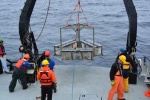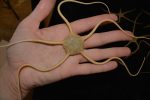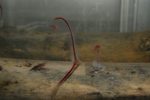Bone and Wood Landers Project
Organic-fall habitats, such as wood and whale falls, support specialized communities within the deep sea, yet large-scale patterns of connectivity and biodiversity between these ecosystems have remained largely unexplored. Specialized decomposer taxa found exclusively at these ecosystems, namely ‘bone-eating’ Osedax polychaetes and the wood-boring xylophagaid bivalves, play an important role as ‘ecosystem engineers’; driving the decomposition of the substrates whilst increasing the organic matter and habitat availability to a wider community of deep-sea organisms.
The BoWLs project has been designed to investigate biodiversity, connectivity and ecosystem function at organic-fall habitats within the deep sea through the deployment of quantitative, experimental benthic landers carrying wood and whale-bone substrates. During 2013, six Bone and Wood Landers (BoWLs) were deployed to depths of 1500 and 3000 m on the Washington-Oregon margin, and recovered after 15 months. Along with the anticipated colonisation of specialized decomposer taxa Osedax and Xylophaga, dominant taxa associated to the substrates included Galatheid squat lobsters, scavenging amphipods, opportunistic polychaetes and ophiuroids (brittle stars).
Combined with collaborative research from the University of Auburn and further experiments within the SW Atlantic (University of Sao Paulo, Brazil), we are employing genetic, taxonomic, community and trophic studies to research bathymetric, regional and inter-basin variations in the ecology of these deep-sea habitat islands. Through this project, we are addressing the following key questions:
1) Does the identity and diversity of dominant bone/wood colonizing communities vary between depths, locations and ocean basins?
2) What is the genetic and species exchange between substrate deployments? Is exchange greater within a depth zone than between depth zones?
3) How does the abundance and species richness of specialized decomposer taxa (Osedax and Xylophaga) influence degradation rates, faunal biomass production, aerobic and anaerobic microbial processes, trophic complexity and species richness associated to the substrates?
Additional Information:
The Halanych Lab: http://metazoan.auburn.edu/halanych/lab/index.html
The Laboratorio de Dinamica Bentica at the Universidad de Sao Paulo: http://ldb.io.usp.br/index.php/en/
More pictures from the BoWLs Recovery Cruise can be seen on Twitter using #BOWLS14






